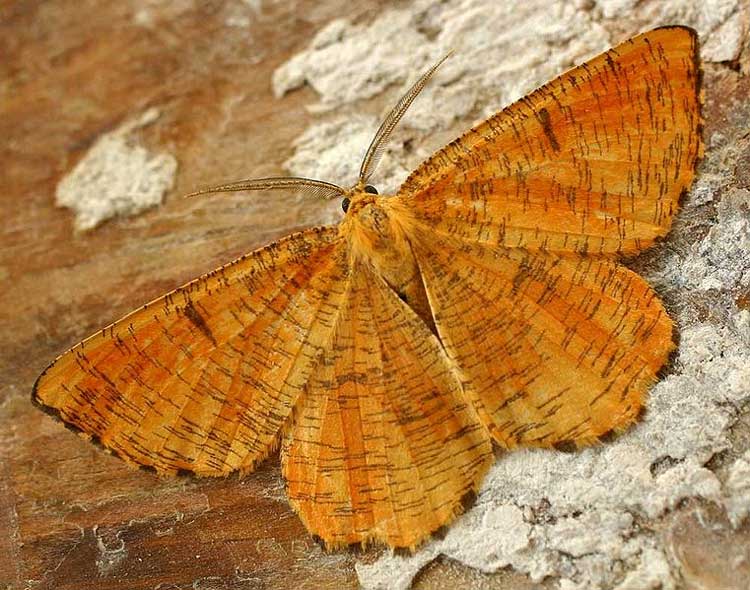
Angerona prunaria , (http://www.entomart.be/)
Superregnum: Eukaryota
Cladus: Unikonta
Cladus: Opisthokonta
Cladus: Holozoa
Regnum: Animalia
Subregnum: Eumetazoa
Cladus: Bilateria
Cladus: Nephrozoa
Cladus: Protostomia
Cladus: Ecdysozoa
Cladus: Panarthropoda
Phylum: Arthropoda
Subphylum: Hexapoda
Classis: Insecta
Cladus: Dicondylia
Subclassis: Pterygota
Cladus: Metapterygota
Infraclassis: Neoptera
Cladus: Eumetabola
Cladus: Endopterygota
Superordo: Panorpida
Cladus: Amphiesmenoptera
Ordo: Lepidoptera
Subordo: Glossata
Cladus: Coelolepida
Cladus: Myoglossata
Cladus: Neolepidoptera
Infraordo: Heteroneura
Cladus: Eulepidoptera
Cladus: Ditrysia
Cladus: Apoditrysia
Cladus: Obtectomera
Cladus: Macroheterocera
Superfamilia: Geometroidea
Familia: Geometridae
Subfamilia: Ennominae
Tribus: Angeronini
Genus: Angerona
Species: Angerona prunaria
Subspecies: A. p. kentearia – A. p. prunaria – A. p. turbata – A. p. valens
Name
Angerona prunaria (Linnaeus, 1758)
References
Duprez, J.N., 2011: Description d'une nouvelle forme d'Angerona prunaria Linné, 1758 (Lepidoptera: Geometridae). Lambillionea 111 (2): 107–108.
Angerona is a monotypic moth genus in the family Geometridae erected by Philogène Auguste Joseph Duponchel in 1829. Its only species, Angerona prunaria, the orange moth, was first described by Carl Linnaeus in his 1758 10th edition of Systema Naturae.[1]
Description
Angerona prunaria is a relatively large and prominent representatives of the geometer moths. It can reach a wingspan of 35–45 mm, rarely up to 56 mm. As in most Lepidoptera, the males are usually slightly smaller than the females.
The ground colour is red to orange or yellow. There is a fine grey to almost black cross stippling and a transverse vein spot in females. The fringes have dark spots. The species is very variable. The males of this species are brighter in colour than the females, both sexes can be found in the typical plain orange form, as well as f. corylaria, which exhibits an orange band on a dark brown ground colour.[2]
Forma
Angerona prunaria f. spangbergi Lampa. Dark cross-band is missing.
Angerona prunaria f. corylaria Thunberg. The basal and marginal ereas are darkened olive brown, the discal area remains in the ground colour.
Angerona prunaria f. pickettaria Prout. With remnants of the ground colour in the disc
Angerona prunaria f. fuscaria Prout. Monochrome dark brown wings.
Angerona prunaria f. pallidaria Prout. Like corylaria, but grey instead of dark brown parts.
Larva
The caterpillars are also variably coloured. They resemble small dead branches to confuse predators. The body colour ranges from a pale yellowish brown to grey-brown to reddish-brown. The sides and the back are patterned with a series of black strokes and dots. On the fifth segment there is a pair of small dorsal humps, on segment ten there is an eye-catching pair of dorsal humps. The head of the caterpillars is brown, they reach a length of up to 50 millimeters
The moth prefers forest areas and is found in central and northern Europe, Russia and the Middle East and east across the Palearctic to Japan.In Hokkaido (Japan) the species is represented by the subspecies Angerona prunaria turbata Prout
The flight time is May to July.
The larva feeds on Prunus spinosa, Lonicera xylosteum , Populus tremula, Frangula dodonei and Vaccinium myrtillus.
Angerona prunaria.jpg
Form corylaria
(1924) Orange Moth (Angerona prunaria) (14557518166).jpg
References
Savela, Markku. "Angerona Duponchel, 1829". Lepidoptera and Some Other Life Forms. Retrieved February 2, 2019.
Prout, L. B. (1912–16). Geometridae. In A. Seitz (ed.) The Macrolepidoptera of the World. The Palaearctic Geometridae, 4. 479 pp. Alfred Kernen, Stuttgart.pdf
External links
"70.230 BF1924 Orange Moth Angerona prunaria (Linnaeus, 1758)". UKMoths. Retrieved 2 February 2019.
"07665 Angerona prunaria (Linnaeus, 1758) - Schlehenspanner". Lepiforum e.V. Retrieved 2 February 2019.
Retrieved from "http://en.wikipedia.org/"
All text is available under the terms of the GNU Free Documentation License

